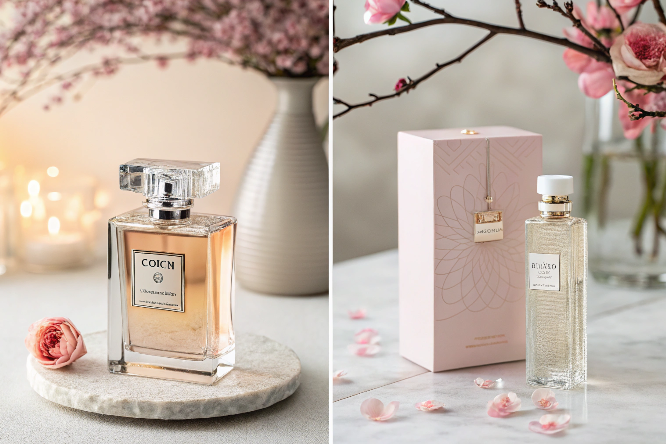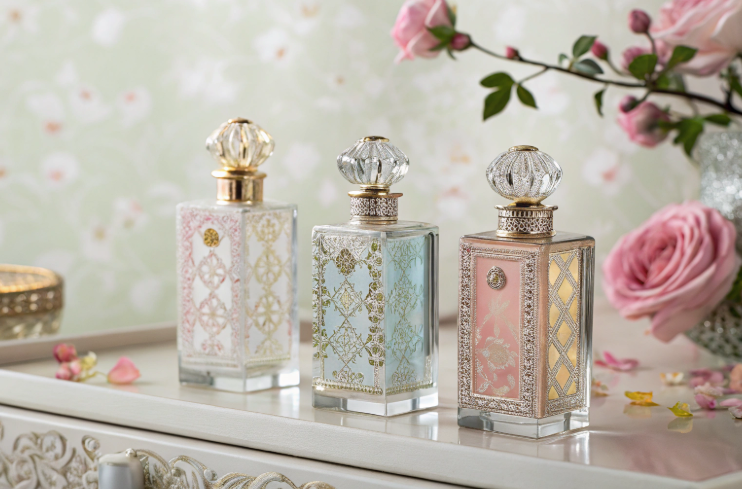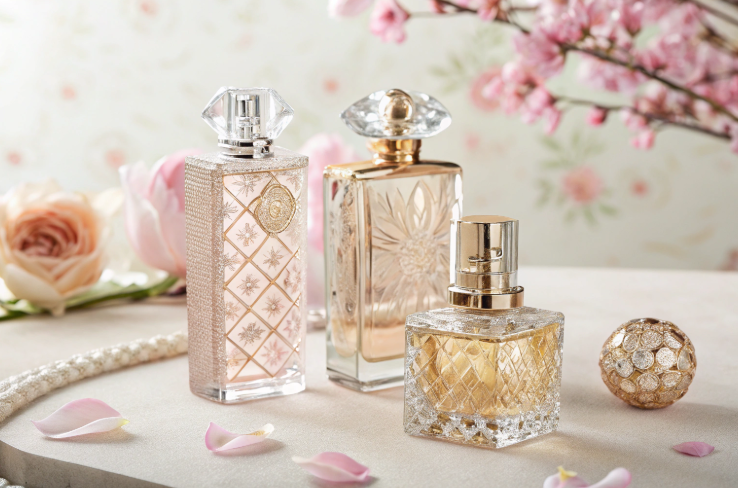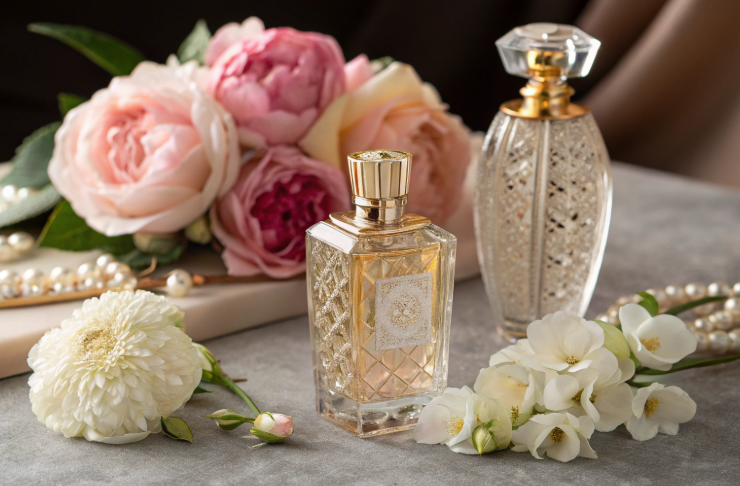Perfume bottles are not merely containers; they are a crucial element of a fragrance’s identity, embodying elegance, luxury, and brand storytelling. The design, material quality, and finishing of perfume bottles significantly influence consumer perception and purchasing decisions. At Paupacking, we specialize in manufacturing premiumPerfume Bottlesthat seamlessly blend exquisite craftsmanship with modern technology, catering to brands that aspire to elevate their fragrance packaging to the highest standards.
This article provides an in-depth exploration of the perfume bottle manufacturing process, diverse bottle types, customization possibilities, quality assurance protocols, market trends, and the unique advantages Paupacking offers as a leading perfume bottles manufacturer and vendor. Each section is expanded to offer comprehensive insights, helping businesses and brands make informed decisions about their packaging needs.


1. The Importance of Perfume Bottles in Branding and Consumer Appeal
Perfume bottles serve as the visual and tactile gateway to a fragrance, creating the first impression that can captivate consumers and convey the essence of the scent within. The bottle’s design, weight, texture, and finish contribute to the overall sensory experience, influencing emotional connections and brand loyalty.
A well-designed perfume bottle reflects the brand’s philosophy and target audience, whether it’s classic sophistication, modern minimalism, or avant-garde artistry. Beyond aesthetics, perfume bottles must ensure product protection, preventing contamination and evaporation while facilitating ease of use.
Paupacking’sPerfume Bottlesare crafted to balance these functional and aesthetic demands, offering bottles that enhance brand storytelling and consumer engagement. Our designs range from timeless classics to innovative contemporary forms, allowing brands to express their unique identity.
The packaging’s tactile qualities—such as the smoothness of the glass, the weight in hand, and the precision of the spray mechanism—play a vital role in consumer satisfaction. Studies show that consumers often associate heavier, well-crafted bottles with higher quality, which can justify premium pricing.
Moreover, the perfume bottle acts as a collectible item for many consumers, extending the product’s life beyond the fragrance itself. This longevity enhances brand visibility and customer retention.
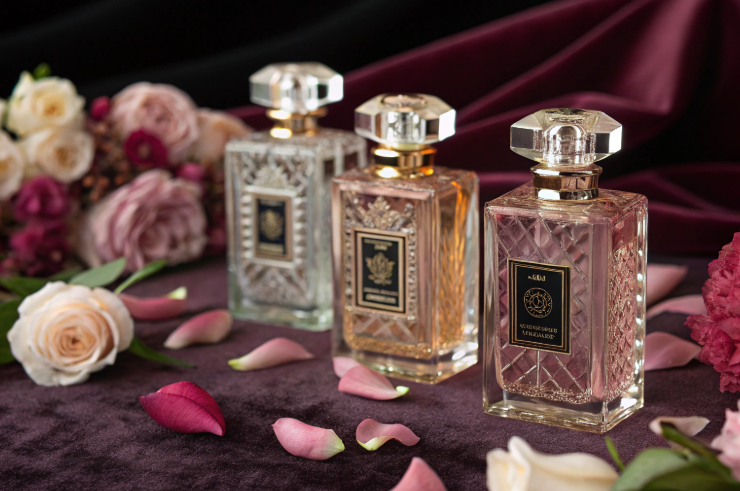

2. Raw Materials and Glass Composition for Perfume Bottles
The foundation of any high-quality perfume bottle lies in the raw materials used to create the glass. The choice and purity of these materials directly affect the bottle’s clarity, strength, and overall aesthetic appeal.
High-Purity Raw Materials
-
Quartz Sand (Silicon Dioxide):Constituting the majority of the glass batch, quartz sand provides the structural backbone. The purity of the sand is critical; impurities can cause discoloration or weaken the glass.
-
Soda Ash (Sodium Carbonate):This lowers the melting temperature of silica, facilitating the glassmaking process and improving workability.
-
Limestone (Calcium Carbonate):Adds chemical durability and hardness, ensuring the bottle withstands handling and environmental exposure.
-
Aluminum Oxide:Enhances surface hardness and scratch resistance, contributing to the bottle’s longevity.
-
Boron Oxide:Used in specialty glasses to improve thermal resistance and glossiness.
-
Trace Elements:Iron, chromium, cobalt, and other elements are added to produce colored glass variants such as amber, green, or cobalt blue, which serve both aesthetic and functional purposes, like UV protection.
Glass Types
-
Soda-Lime Glass:The most common type used for perfume bottles due to its excellent clarity and cost-effectiveness.
-
Borosilicate Glass:Offers superior thermal and chemical resistance, ideal for high-end or specialty bottles.
-
Lead Crystal Glass:Contains lead oxide, providing brilliance and weight, often used in luxury packaging.
Paupacking sources and processes these raw materials with meticulous quality control to produce glass that meets the highest standards for perfume bottles. Our glass is free from harmful substances, ensuring safety and compliance with global regulations.
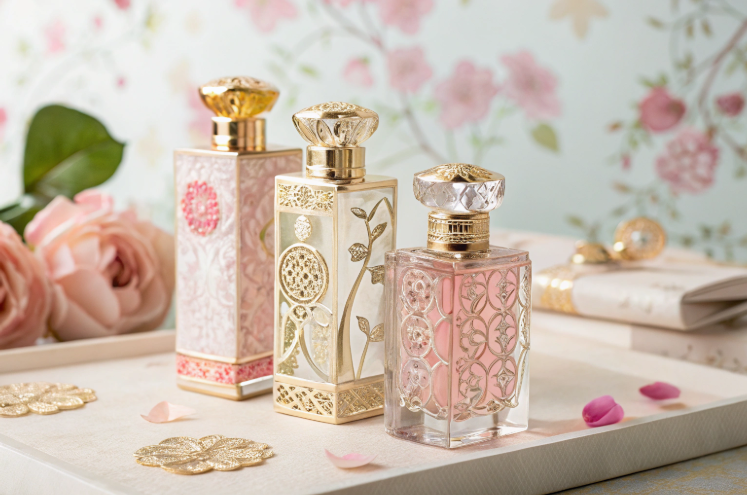

3. Manufacturing Processes of Perfume Bottles
The creation of a perfume bottle is a sophisticated process combining traditional glassmaking artistry with modern precision engineering. Each step is critical to achieving the desired quality and aesthetic.
3.1 Glass Melting and Conditioning
Raw materials are heated in high-temperature furnaces until they melt into a homogeneous molten glass. This molten glass is conditioned to achieve the optimal viscosity for forming, ensuring smooth flow and uniformity.
3.2 Forming Techniques
Two main forming techniques are employed:
-
Blow and Blow:Molten glass is first shaped into a parison and then blown into a mold to form the final bottle. This method allows for narrow necks and complex shapes.
-
Press and Blow:Molten glass is pressed into a parison mold before being blown into the final shape. This technique offers greater control over wall thickness and is suitable for bottles requiring precise dimensions.
Both methods are automated in Paupacking’s facilities, ensuring consistency and scalability.
3.3 Annealing
Post-forming, bottles enter an annealing lehr where they are cooled gradually to relieve internal stresses. This process is essential to prevent cracks and enhance mechanical strength.
3.4 Decoration and Finishing
Decoration techniques include:
-
Screen Printing:For vibrant, durable logos and designs.
-
Hot Stamping:Metallic finishes for a luxurious look.
-
Electroplating:Adds reflective coatings.
-
Frosting and Etching:Creates textured surfaces.
-
Engraving:For intricate patterns or branding.
Final assembly includes fitting caps, sprayers, and collars, ensuring functionality and aesthetics.
Paupacking integrates these processes with rigorous quality checks to deliver flawless perfume bottles.
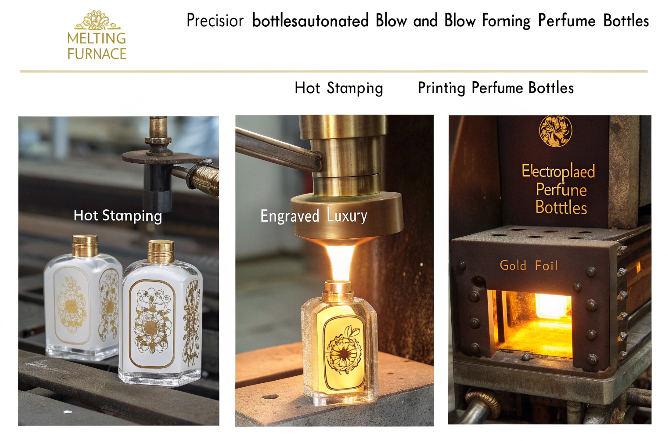
4. Types of Perfume Bottles
The diversity of perfume bottles reflects the wide range of fragrance styles and brand identities. Understanding these types helps brands select packaging that aligns with their vision.
Classic Bottles
Timeless shapes such as rectangular, oval, or round bottles with clean lines and minimalist design. These appeal to traditional and luxury markets emphasizing elegance and simplicity.
Luxury Bottles
Intricately designed bottles featuring crystal cuts, embossing, or unique silhouettes. Often used for limited editions or high-end fragrances, these bottles serve as collectible art pieces.
Travel Bottles
Compact and durable, designed for portability without compromising style. Ideal for consumers on the go.
Rollerball Bottles
Equipped with a roller applicator, these bottles allow precise and convenient application of perfume oils or concentrated fragrances.
Spray Bottles
The most common type, featuring atomizers that deliver a fine mist. Variations include different spray mechanisms and ergonomic designs.
Paupacking offers an extensive catalog ofPerfume Bottlescovering all these types, customizable to brand requirements.
5. Customization Services for Perfume Bottles
Customization is vital for brand differentiation and consumer engagement. Paupacking provides comprehensive customization options:
Bottle Shape and Size
Custom molds allow creation of unique bottle shapes and volumes, enabling brands to express their identity and stand out.
Color and Finish
Glass can be tinted in clear, frosted, amber, cobalt blue, or custom colors. Surface finishes such as matte or glossy, combined with frosting or etching, enhance tactile and visual appeal.
Logo and Labeling
Screen printing, hot stamping, embossing, and digital printing allow precise branding. Metallic foils and textured labels add luxury.
Cap and Sprayer Options
Variety in materials (metal, plastic, wood) and styles (spray, rollerball, dropper) provide functional and aesthetic flexibility.
Packaging Solutions
Custom-designed boxes, inserts, and wrapping ensure safe transport and attractive presentation.
These services empower brands to create signature perfume bottles that resonate deeply with consumers.
6. Quality Assurance and Compliance
Paupacking’s commitment to quality is reflected in stringent controls:
-
Material Safety:Lead-free, BPA-free, and food-grade glass.
-
Dimensional Accuracy:Precision molding ensures consistent fit and function.
-
Surface Quality:Bottles are free from bubbles, cracks, or imperfections.
-
Performance Testing:Durability, leak-proofing, and spray mechanism reliability.
-
Regulatory Compliance:Adherence to FDA, EU, and other international standards.
This rigorous approach guarantees the reliability and safety of Paupacking’sPerfume Bottles.
7. Market Trends Influencing Perfume Bottle Design and Demand
Several trends shape the perfume bottle market:
Sustainability
Growing consumer demand for environmentally friendly packaging drives innovation in recyclable and reusable glass bottles.
Minimalism
Clean, simple designs with subtle branding appeal to modern consumers valuing understated elegance.
Personalization
Custom and limited-edition bottles cater to niche markets and collectors.
Technology Integration
Smart packaging incorporating NFC or QR codes enhances consumer engagement and authenticity verification.
Vintage Revival
Classic and retro designs evoke nostalgia and trust, appealing to diverse demographics.
Paupacking continuously adapts itsPerfume Bottlesportfolio to align with these evolving trends.
8. Paupacking’s Advantages as a Perfume Bottles Manufacturer and Vendor
Paupacking distinguishes itself through:
-
Advanced Manufacturing:Combining automation with artisanal expertise.
-
Customization Expertise:Tailored solutions for unique brand identities.
-
Sustainability Commitment:Eco-conscious materials and processes.
-
Global Distribution:Efficient logistics and customer support.
-
Comprehensive Services:From design consultation to final packaging.
OurPerfume Bottlesexemplify our dedication to quality and innovation.
9. Expanding Applications of Glass Bottles Beyond Perfume
Glass bottles manufactured for perfume also find applications in:
-
Cosmetics:Serums, oils, lotions.
-
Pharmaceuticals:Essential oils, tinctures.
-
Luxury Food & Beverage:Miniature spirits, gourmet extracts.
Paupacking’s versatile glass bottles serve these markets with adaptable designs and finishes.
10. Choosing the Right Perfume Bottle Manufacturer
Selecting a manufacturer involves assessing:
-
Product Quality:Clarity, strength, and finishing.
-
Customization Capabilities:Ability to realize unique designs.
-
Production Capacity:Scalability and lead times.
-
Compliance:Adherence to safety and environmental standards.
-
Customer Service:Support and responsiveness.
Paupacking excels in all these areas, making us a preferredPerfume Bottlesmanufacturer and vendor.
Table: Comparison of Perfume Bottle Types and Features
| Bottle Type | Description | Typical Use Case | Customization Options |
|---|---|---|---|
| Classic Bottles | Timeless shapes, minimalist design | Everyday perfumes | Shape, color, logo |
| Luxury Bottles | Intricate designs, crystal cuts | High-end fragrances | Embellishments, metallic finishes |
| Travel Bottles | Compact, durable | On-the-go use | Size, cap type |
| Rollerball Bottles | Easy application | Perfume oils, serums | Rollerball design, labeling |
| Spray Bottles | Atomizer for fine mist | Most perfumes | Sprayer style, decoration |
Perfume bottles are a vital component of fragrance branding and consumer experience. Paupacking’s premiumPerfume Bottlescombine artistry, quality, and innovation to help your brand stand out.
Explore Paupacking’s offerings today and partner with a trusted manufacturer and vendor dedicated to excellence in glass perfume bottles.




